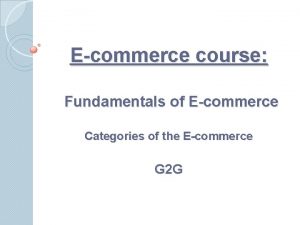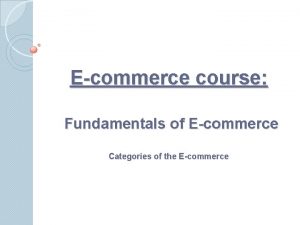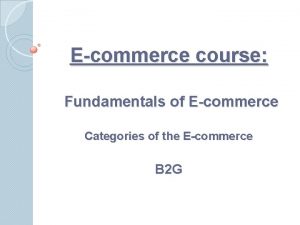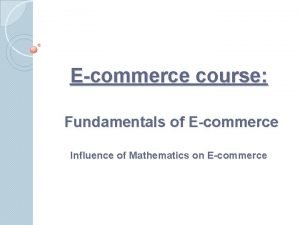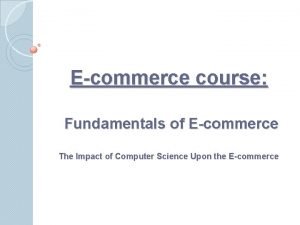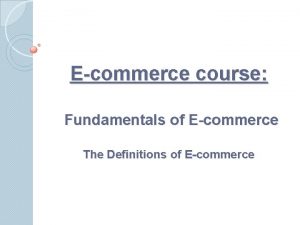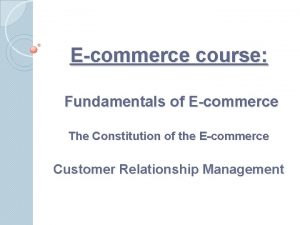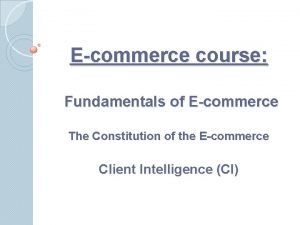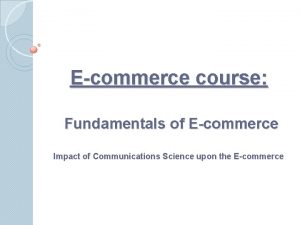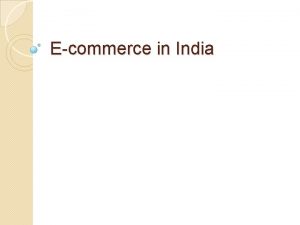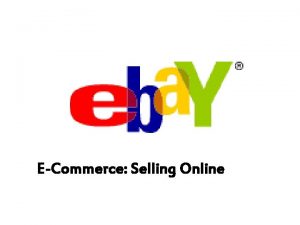Ecommerce course Fundamentals of Ecommerce Categories of the



















![Refrences [1] Qin Z. , Li S D. An Compendium to E-Commerce. Beijing: Higher Refrences [1] Qin Z. , Li S D. An Compendium to E-Commerce. Beijing: Higher](https://slidetodoc.com/presentation_image_h2/53dc25aa3258eafb06a55a5d00bbf20c/image-20.jpg)
- Slides: 20

E-commerce course: Fundamentals of E-commerce Categories of the E-commerce B 2 C

B 2 C In B 2 C (Business to Customer) e-commerce, Internet is resorted by businesses or enterprises to provide customers goods and services via websites. Presently, various types of B 2 C websites spread all over Internet to supply customer a variety of goods and services, varying from flowers and books, to computers and cars etc. Because of the restrictions of a variety of factors, e-commerce of this categories only takes up a small proportion whether at present or in the far future. Nevertheless, in the long run, B 2 C will rapidly develop and be a great part of e-commerce ultimately.

From the perspective of the business relations between enterprises and customers, B 2 C falls into two categories: seller (enterprises)— the personal buyers, and buyer (enterprises)—the personal sellers. Seller (enterprise)-personal buyers, is the categories in which enterprises sell goods and commodities to individual customers. In this e-commerce categories, the sellers first open an online store, then release the information on variety, specification, price, and capability of the goods or on variety, price and measures of service, by which the individual customers choose goods, place an order and decide to make online or off-line payment, and last deliver goods to the customers.

By this kind of online shopping, customers can acquire further information on goods, shop around, purchase goods at the lowest cost and save shopping time without going outside. Without doubt, this e-commerce categories requires the support of high-efficient, low-cost logistics, the representative of which is the global distinguished online bookstore Amazon (http: //www. amazon. com). Enterprise personal sellers, is the category in which business purchases goods or service from individuals. This categories is usually used for online job application. For example, many enterprises advertise various job offers in Shenzhen Human

By this categories, enterprises release information on needed talents at first and then appliers negotiate with enterprises online, which is very popular in this society with big talents flow for it offers a communication platform and bridges the enterprises and individuals, thus making full use of human resources. E-commerce of B 2 C can be divided into tangible and intangible goods and services, of which the latter can be completed by network, while the former cannot unless the traditional methods are resorted to.

Thanks to the information transmission and processing abilities of computer network, intangible goods and services (e. g. einformation, computer software, digital audiovisual entertainment products, etc. ) in general can be presented to customers directly via network. E-commerce categories of intangible goods and services are mainly online subscription categories, advertisement-supported pattern and online domination categories.

1. Online subscription categories Customers subscribe intangible goods and services provided by enterprises and can consume them directly on line. This categories is mainly used by some online enterprises to sell newspapers, magazines and programs of cable TV. The online subscription categories are shown as follows: � Online Publication. Publishers supply customers e-publications via Internet besides the traditional ones. Online publication merely releases e-journals, which can be downloaded by consumers by subscribing.

This is not an ideal categories for information sales, because common users will give a wide berth to the charge information service in information era, though it is rather low in price, since information can be obtained from various channels. Thereby, some online publishers adopt double-track system (the combination of free reading and charge subscription) to maintain certain business return by attracting a quantity of consumers.

� Online Services. Online service providers provide multiform online information services by fixed monthly charges. The online service providers have their own specific client mass in general. For example, the client mass of American On Line (AOL, for short) is the household consumers, and that of Microsoft network is Windows users. The subscriber can enjoy various services of information by paying monthly. Online services generally aim at the definite social community to develop consumers’ loyalty. In the United States, each computer sold preassembles free-trial software. The strong marketing offensive of the online service providers makes the steady upswing of their consumers.

� Online Entertainment. The service categories has achieved a measure of success and is greatly interested by people. Online amusement providers provide customers online games by charging certain subscription fee. At present, network games have become one of the network focuses, and Microsoft, Excite, and Infoseek etc. have made positive response to it. Actually, the network operators have already shown great foresight to obtain access frequency and loyalty of consumers by some free or cheap online amusement.

2. Advertisements-supported categories Online service providers provide customers online information service freely and obtain income from advertisements published in the websites. This is the most successful categories, though it does not directly charge from customers. For example, many online search service websites such as Yahoo maintain operation by charge advertisements. From the standpoint of netizens, information search is the basis to locate information needed in the information sea of Internet.

Therefore, businesses also are willing to release advertisements in information dragnet, which enables customers to login directly into the websites of enterprises. The success of these online service providers depend mainly on that their web pages can attract a large number of advertisements and the attention of a large number of customers.

3. Online donation categories This categories is usually adopted by software companies to submit software to customers to improve its popularity and market share. Some software companies offer alpha-version products to Internet users freely. As for the users, they can try out the products by downloading or feedback their advice or suggestions to software companies. After a period of trial, if satisfied, the customers may purchase the formal-version software. Software companies can lower cost, expand trial community, and improve testing result and

The American Netscape Corporation adopted this method to popularize its browser, thus dominated the browser software market and made outstanding achievements. E-commerce categories of tangible goods and services. Inquiry, ordering and payment etc. of tangible goods can be carried out online except the ultimate delivery carried out by traditional methods. This e-commerce categories is also called online sales. Currently, businesses adopt the following two types of online sales: One, set up independent online virtual shops. Two, participate in and join online shopping mall. This categories broadens the channel of online sales and offers more opportunities to the company.

Compared with the traditional store retailing, even if the scale of the business is very small, online sales still can spread all over the world. Different from common tangible stores, online shops have no large stock. If it is a pure virtual shop, it can send orders directly to manufacturers or wholesalers, thus saving storage and cost inventory to a great extent.

In the eyes of the business administration, enterprises can adopt the following strategies to develop B 2 C: (1) Appropriate strategies. Because of profound changes of relations between enterprises and customers, there came new value chain and value chance. The most important about e-commerce is to determine their goods. For example, when doing B 2 C e-commerce, the company is to develop new products or services or to extend the market of the current goods or services. Different strategies will bring about different performances.

(2) Coordinate market channels. The development of B 2 C ecommerce will undoubtedly bring about the extension of market channels and probably impact the existing channel relations, which needs the administrators’ effective coordination. The online marketing channels of B 2 C with originally traditional marketing ones can mutually facilitate, thus bringing more benefits to business. For instance, the retail business can facilitate the communications between business and consumers, enhance the original market channels and improve market share by releasing wide-ranging, wellillustrated goods information on line and update it timely, or provide customers technical support via Internet.

(3) Strengthen the supervision of the information. In e-commerce of B 2 C, the business can release the exuberant information of background, products or services, and electronic advertisements via Internet at lower cost to extensive potential market. This kind of information publication is closely related to its market competitive position. Because the information released by enterprises must be beneficial to improve corporate image, brand popularity and reputation and go beyond the original market dealing barrier, the enterprise should carry out market investigation and filter information carefully. The information management (IM) operations of the business are at the request to pay attention to the interaction with consumers on Internet, customer acquaintance by information communication and service of more valuable information, thus

(4) Reinforce transaction price supervision. Business of B 2 C should release real time price of products. When setting the prices of online products, enterprises have to take into account whether its price is in accordance with the product price structure of the traditional market. To be simple, the business can adopt standard pricing strategy in both the traditional market and network market. But this pattern cause the conflict with the spatial pricing policy of the business. One of the solutions is to adopt differentiation pricing policy with the list of various dispatching cost so as to prevent unfavorable market feedback.
![Refrences 1 Qin Z Li S D An Compendium to ECommerce Beijing Higher Refrences [1] Qin Z. , Li S D. An Compendium to E-Commerce. Beijing: Higher](https://slidetodoc.com/presentation_image_h2/53dc25aa3258eafb06a55a5d00bbf20c/image-20.jpg)
Refrences [1] Qin Z. , Li S D. An Compendium to E-Commerce. Beijing: Higher Education Press, 2001. [2] Qin Z. , Xie G T. , Li S D. , & Jia X L. ECommerce System Structure and System Design. Xi’an: Xi’an Jiaotong University Press, 2001. [3] Qin Z. , Han Y. & Yan L X. Computer System Intergration and E-commerce. Xi’an: Xi’an Jiaotong University Press, 2001. [4] Qin Z. , Wang Z M. & Bao F M. Design Practice of Virtual Network. Xi’an: Xi’an Jiaotong University Press, 2001. [5] Qin Z. , Liu X Y. & Wang LR. Case Study on E-commerce. Xi’an: Xi’an Jiaotong University Press, 2001. [6] Qin Z. , Wang Y L. , Zhang L. & Wei M T. Virtual Business Management. Xi’an: Xi’an Jiaotong University Press, 2001. [7] K. Laudon, C. Traver. E-Commerce: Business, Technology, Society (3 rd Edition). Prentice-Hall, Inc. NJ, USA. 2006. [8] William G. Page. Jr. A Handbook of Oracle 8/8 i Development and Application (the first edition) Beijing: Machinery Industry Press, 2000. [9] Wang Q. , Qiu R J. & Wang H W. The Design and Achievement of Client’s Information Management System. Information Techniques, Issue 7, 2000, & Issue 87, 2000, 1820. [10] F. Damanpour. E-business E-commerce Evolution: Perspective and Strategy. Managerial Finance. Vol. 27 (7): 16 -33, 2001. [11] Yu Z T. , Song L Z. Che W G. & Guo J Y. The Strategies of Database Techniques in Shopping Vehicles on Internet. Computer Application, No. 8, Vol (20), 2000, 6668. [12] W. David. E-commerce: Strategy, Technologies And Applications. TATA MCGRA, India, 2000. [13] Zhang C X. , Tang J G. & Xie Y F. The Establishment of Bamboo Product Information System Database and the Design of Information Inquiry Function. Journal of Najing Forestry University Sum No. 70, Volume 12, 1996. [14] Daniel I. Joshi, Pavel A. A Complete Collection of References for Java Programmers. (the first edition) Beijing: China Water Conservancy and Hydroelectricity Press, 1999. [15] E. Turban, C. Cohen, I. M. Copi et al. Introduction to E-Commerce. Pearson Education, NJ, USA, 2003. [16] Yen-Liang Chang, Chen, S. Chyun-Chyi Chen, I. Workflow process Definition and Their Applications in E-commerce. Multimedia Software Engineering, 2000. Proceedings. International Symposium on, 2000, 193200. [17] Weaver, A. C. Vetter, R. J. Whinston, A. B. Swigger, K. The future of E-commerce. Computer, Volume: 33 Issue: 10, Oct. 2000, 3031. [18] S. Korper, J. Ellis. The E-commerce Book: Building the E-empire. Morgan Kaufmann, San Fransisco, USA, 2001. [19] Bhaskaran, K. Jen-Yao Chung Das, R. Heath, T. Kumaran, S. Nandi, P. An E-business Integration & Collaboration Platform for b 2 b E-commerce. Advanced Issues of E-Commerce and Web-Based Information Systems, WECWIS 2001, Third International Workshop on, 2001, 120122. [20] A. Panagariya. E-Commerce, WTO and Developing Countries. World Economy, Vol. 23 (8): 959978, 2002. [21] Pi Y. On Technological Crime in the Field of Finance. Legal Science Review, 2000. [22] Qu X W. Crime on Internet and Its Containing. Legal Science Study, 2000. [23] Wang Y. A Brief Analysis on E-commerce Law Issues. Legal Science Review, 2000. [24] Wi J P. E-commerce in China: Problems and Their Countermeasures. China Computer Paper, 1999. [25] Venkatraman, Mahadevan; Singh, Munindar P. Verifying Compliance with Commitment Protocols. Autonomous Agents and Multi-Agent Systems; 13872532; No. 3 (2), 1999. [26] Shaw, Michael J. Electronic Commerce: Review of Critical Research Issues. Information Systems Frontiers; 13873326; No. 1 (1), 1999. [27] Garrett, S. G. E. ; Skevington, P. J. An Introduction to Electronic Commerce. BT Technology Journal; 13583948˗No. 3 (17), 1999. [28] Unitt, M. , Jones, I. C. EDI-The Grand Daddy of Electronic Commerce. BT Technology Journal; 13583948; No. 3 (17), 1999. [29] Trask, N. T. Meyerstein, M. V. Smart Cards in Electronic Commerce. BT Technology Journal; 13583948; No. 3 (17), 1999. [30] S. S. Y. Shim, V. S. Pendyala, M. Sundaram, J. Z. Gao, Business-to-Business E-Commerce Frameworks. Computer, vol. 33(10): 4047, 2000. [31] D. Kinyon. Quarterly retail ecommerce sales: 4 th quarter 2007. US Census Bureau News 2008, CB 08 -24. [32] A. K. Ghosh, T. M. Swaminatha. Software security and privacy risks in mobile e-commerce. Communications of the ACM, Vol. 44(2): 5157, 2001. [33] S. Hawk. A Comparison of B 2 C E-Commerce in Developing Countries. Electronic Commerce Research, Vol. 4(3): 181199, 2004. [34] Lu X D. Making and Implementing E-commerce Strategies with Chinese Characteristics. Dongyue Series, 2001(01): 6063. [35] Liu J. Key Points and Measures of E-commerce Strategies in Canana. Global Watch of Science and Technology and Economy, 2000(6): 1415. [36] Tian H. Japan Plans to Be the Most Advanced Country in IT within Five Years. East Web. [37] He D G. Catching up with and Surpassing America: the Dream of Japanese IT Revolution. Army Paper, May 16 th, 2002. [38] Japan Publicizes New IT Strategies of the Year 2002. People’s Daily, June 28 th. 2001. [39] A. Tsalgatidou, J. Veijalainen.
 Consumer oriented e commerce application
Consumer oriented e commerce application E business fundamentals
E business fundamentals Ecommerce fundamentals classes
Ecommerce fundamentals classes![[author] java message service - jms fundamentals course [author] java message service - jms fundamentals course](data:image/svg+xml,%3Csvg%20xmlns=%22http://www.w3.org/2000/svg%22%20viewBox=%220%200%20200%20200%22%3E%3C/svg%3E) [author] java message service - jms fundamentals course
[author] java message service - jms fundamentals course![[author] java message service - jms fundamentals course [author] java message service - jms fundamentals course](data:image/svg+xml,%3Csvg%20xmlns=%22http://www.w3.org/2000/svg%22%20viewBox=%220%200%20200%20200%22%3E%3C/svg%3E) [author] java message service - jms fundamentals course
[author] java message service - jms fundamentals course Course title and course number
Course title and course number Course interne moyenne externe
Course interne moyenne externe Half brick wall in stretcher bond
Half brick wall in stretcher bond Tư thế ngồi viết
Tư thế ngồi viết Tư thế worms-breton
Tư thế worms-breton Quá trình desamine hóa có thể tạo ra
Quá trình desamine hóa có thể tạo ra Thẻ vin
Thẻ vin Công thức tính thế năng
Công thức tính thế năng Từ ngữ thể hiện lòng nhân hậu
Từ ngữ thể hiện lòng nhân hậu Bổ thể
Bổ thể Biện pháp chống mỏi cơ
Biện pháp chống mỏi cơ Diễn thế sinh thái là
Diễn thế sinh thái là độ dài liên kết
độ dài liên kết Thế nào là giọng cùng tên? *
Thế nào là giọng cùng tên? * Các môn thể thao bắt đầu bằng tiếng đua
Các môn thể thao bắt đầu bằng tiếng đua Lời thề hippocrates
Lời thề hippocrates


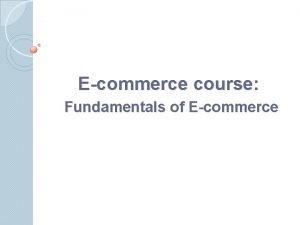
![[author] java message service - jms fundamentals course [author] java message service - jms fundamentals course](https://slidetodoc.com/wp-content/uploads/2020/09/381247_2ef7a792adac8a30d3544ffd2fa051e8-300x225.jpg)
![[author] java message service - jms fundamentals course [author] java message service - jms fundamentals course](https://slidetodoc.com/wp-content/uploads/2020/12/3153209_df26b9e82fd50550f981af9733a3f0c2-300x225.jpg)
















